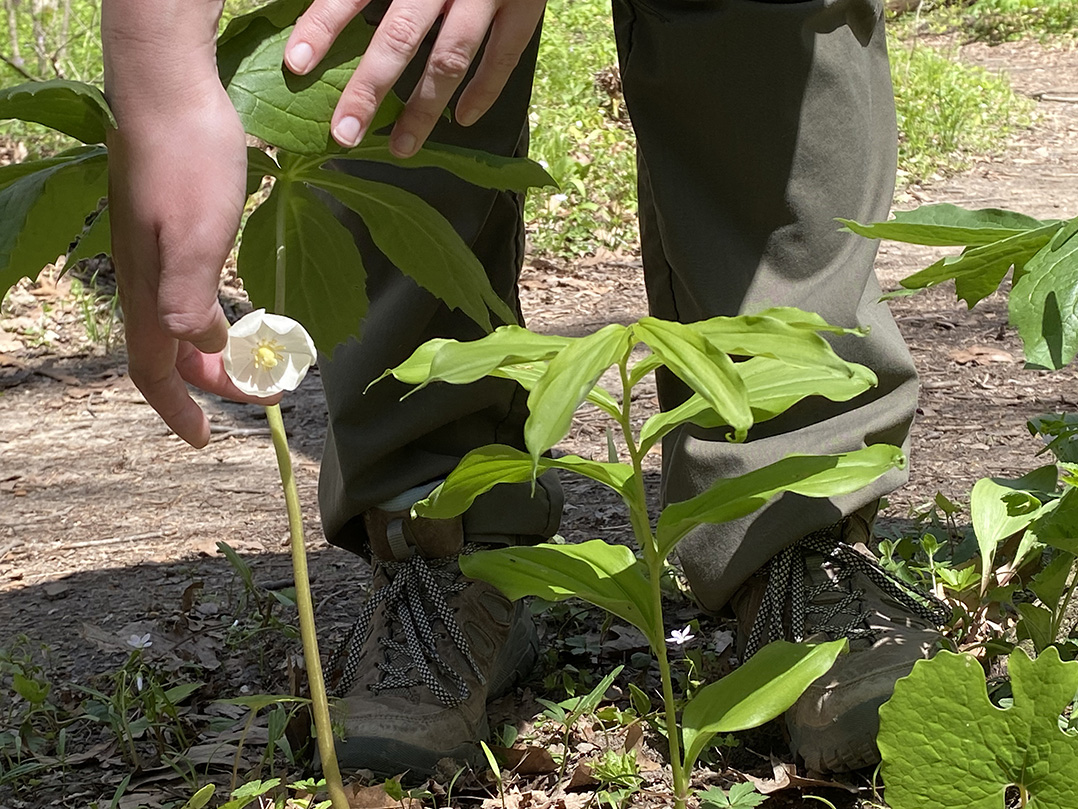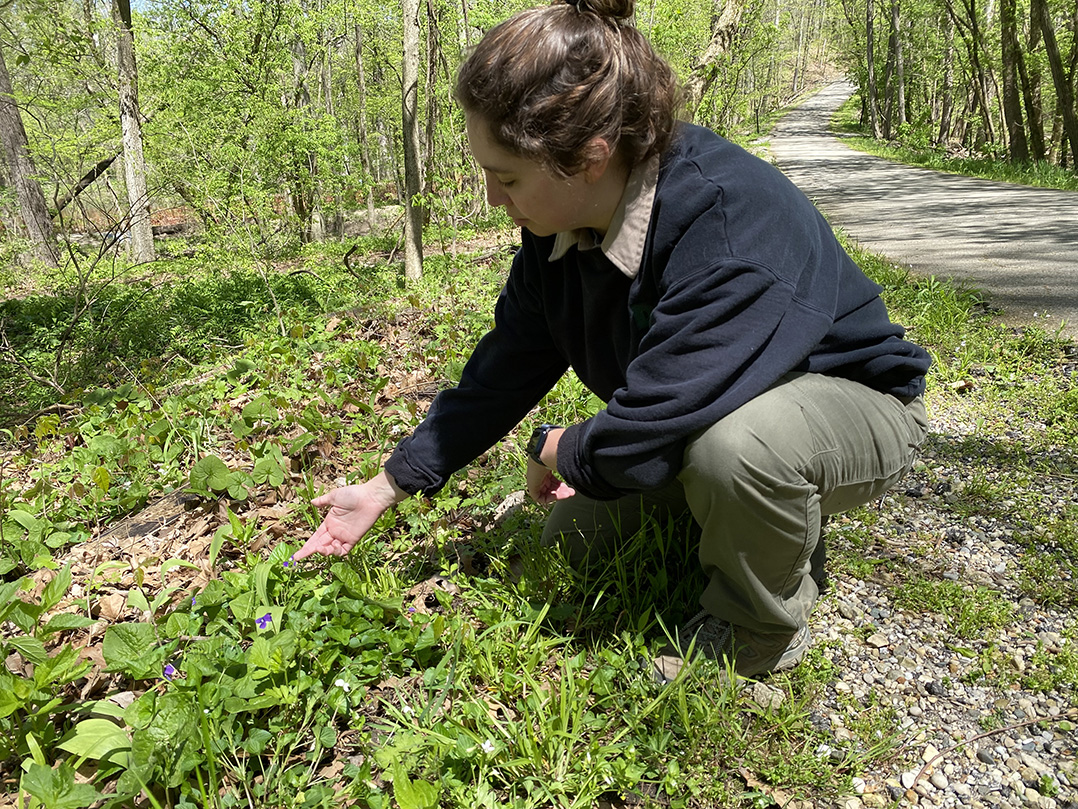Spring is a beautiful time of year at Fort Harrison State Park, especially when the sun is shining. On a recent spring afternoon, the surface of Delaware Lake glimmered, birds called to each other as they flitted through the trees and a trio of turkey vultures soared majestically overhead.
Naturalist Emilie Sweet has gotten pretty good at identifying birds by their call, even if she can’t see them — and most of them were difficult to spot because they don’t stay still for very long.
“Birds are migrating, and springtime is when we see a lot of really cool stuff here,” she said, noting that the park is a hotspot for warblers. “Last year, we saw a great blue heron in May. It was an adult, so he had all of his beautiful plumage.”
“That was a redwing blackbird,” she said, suddenly pausing during a walk along Harrison Trace Trail, but the bird proved to be elusive, albeit loud.
Plants don’t move around, though, and there is an abundance of flora throughout the park offering vibrant blooms for visitors to enjoy while listening to all the birds who make their home in the 1,700-acre park in the heart of Lawrence.
Redbud trees, for example, are a native tree with distinct spring flowers. Their purple blooms appear early in the season and can last several weeks or longer, depending on where they are located, Sweet said.
“That’s something to look out for,” she said. “And then our dogwoods are flowering right now, as well. We might see one a little farther out the trail — they have really large white flowers. So, they kind of stick out really well, too.”
The forest also offers numerous spring blooms closer to the ground. Sweet identified prairie trillium next to the trail — with its distinctive maroon flowers — and wild ginger hiding under some leaves.
“It’s one that a lot of people don’t see, because it is covered,” she said. “Wild ginger is a really great native ground cover and a really great option to replace any invasive ground cover some people might have in their yards.”
Tiny cream and blue violets were also along the side of the trail, as well as golden ragwort.
What flowers visitors can see varies from week to week.
“Our ephemerals, they have short-lived flowers,” Sweet said. “Our bloodroots are around for two weeks in March, and we have snow trilliums in early March — they don’t stick around very long, so it’s a treat to be able to see those. Mayapples are starting to bloom right now, which we’ll see up here, and we’ve got wild geranium.”
The geranium and a patch of nearby phlox provided a pretty combination of pink and purple flowers.

A little way down a section of Fall Creek Trail was a large patch of drooping trillium, with flowers that — as the name suggests — droop. They and the mayapple flowers can be difficult to see without reaching down to lift some leaves.
Sweet said mayapples bear fruit, usually in May, that are small and green — similar to an apple, but much smaller. They are edible, but Sweet said she hasn’t had an opportunity to taste one.
“Box turtles really, really love mayapples,” she said. “So, usually when they’re ripe, box turtles are ready to grab them. You don’t find them too often in the wild when they’ve ripened and fallen off.”
Sweet said springtime in the park is her favorite time of year.
“It brings more people to the park, it brings a lot more wildlife to the park that you don’t normally get to see,” she said. “It’s just really exciting. I like to take note of when I notice things every year, like when I noticed my first flower or when I noticed my first leaf on a tree, things like that. So, springtime is definitely a big favorite for us. I can even tell you when the first flower I saw this year — I took a picture of it. It was a harbinger of spring, which is fitting. That’s the name of the flower — harbinger of spring.”
Looking back in her phone, Sweet said it was March 4, following some warm weather, that she looked for and found the tiny blooms.
Other flowers that will start blooming as spring progresses include Virginia spiderwort and zigzag spiderwort. Sweet noted that visitors also can hear and see frogs, which start their breeding season soon.
“We’ve already heard them vocalizing — they’re out at duck pond,” she said. “And then salamanders. We have some eastern redback salamanders that we sometimes find out here. It’s a really common salamander to see.”
Bird migration also will ramp up with more warblers and birds of prey. During the walk, Sweet identified a wren, bluejay, woodpecker and cowbird, among others, and right at the end, an osprey made an appearance high in the sky. Its distinctive wings allowed Sweet to identify the raptor, which she said she had never seen before at the park.
For more about Fort Harrison State Park, visit in.gov/dnr/state-parks/parks-lakes/fort-harrison-state-park.

Bird walks at Fort Harrison State Park
To help visitors get the most out of the spring migratory bird season, Fort Harrison State Park offers weekly bird-watching walks led by volunteers. The walks take place at 8 a.m. Sunday mornings each week through May 26.
Those interested in participating are encouraged to bring binoculars, water and appropriate footwear for a two-hour walk.
The group meets at the northeast corner of Delaware Lake parking lot. Registration is not required for this free event.
For more about events at Fort Harrison State Park, visit in.gov/dnr/state-parks/parks-lakes/fort-harrison-state-park.



